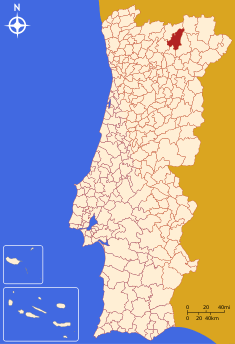Valpaços Municipality
| Valpaços | |||
| Municipality (Concelho) | |||
|
|||
| Official name: Município de Valpaços | |||
| Country | |||
|---|---|---|---|
| Region | Norte | ||
| Subregion | Alto Trás-os-Montes | ||
| District | Vila Real | ||
| Municipality | Valpaços | ||
| Civil Parishes | (see text) | ||
| Center | Valpaços | ||
| - elevation | 515 m (1,690 ft) | ||
| - coordinates | 41°36′43″N 7°21′3″W / 41.61194°N 7.35083°W | ||
| Length | 40.58 km (25 mi), Southwest-Northeast | ||
| Width | 25.90 km (16 mi), North-South | ||
| Area | 548.74 km2 (212 sq mi) | ||
| Population | 19,154 (2001) | ||
| Density | 34.91 / km2 (90 / sq mi) | ||
| LAU | Concelho/Câmara Municipal | ||
| - location | Largo do Jardim, Valpaços, Valpaços | ||
| - elevation | 438 m (1,437 ft) | ||
| - coordinates | 41°36′35″N 7°18′44″W / 41.60972°N 7.31222°W | ||
| President | Francisco Baptista Tavares (PPD-PSD) | ||
| Municipal Chair | João Manuel Medeiros Mateus (PPD-PSD) | ||
| Timezone | WET (UTC0) | ||
| - summer (DST) | WEST (UTC+1) | ||
| ISO 3166-2 code | PT- | ||
| Postal Zone | 5430-469 Valpaços | ||
| Area Code & Prefix | (+351) 278 XXX XXX | ||
| Demonym | Valpacense | ||
| Patron Saint | Nossa Senhora da Saúde | ||
| Municipal Address | Largo do Jardim 5430-469 Valpaços | ||
| Municipal Holidays | 6 November | ||
 Location of the municipality of Valpaços in continental Portugal
| |||
| Wikimedia Commons: Valpaços | |||
| Website: http://www.valpacos.pt | |||
| Statistics from INE (2004); geographic detail from Instituto Geográfico Português (2010) | |||
Valpaços (Portuguese pronunciation: [ˌvaɫˈpasuʃ]) is a municipality in northern Portugal with a total area of 548.74 km² and a total population of 19,154 inhabitants.[1][2][3]
History
The first documents that cite Valpaços date back to the 12th century. Its toponymy evolved from pre-national settlements, and started as a small enclave inhabited by nobles and signeurial family estates, attracted by the privileges of colonial settlement so close to the Spanish border. The nascent Portuguese community was susceptible to attacks from Spain, who maintained their land claims to the Portuguese territory. The establishment of border settlements fixed the border.
Historically, Vale de Paço (and later Vale de Paços until the 19th century) was an area with roots in the Roman period of settlement, yet influenced by Germanic settlers before Portugal became a Kingdom.
The most important event in the regions history occurred in the 19th century. On 16 November 1846, during the Patuleia conflict, a movement that was apolitical turned bloody, resulting in the deaths of 200 people, before the wave proceeded into the lands of Murça.
Geography

Valpaços is located in the northern interior of Portugal in the Alto Trás-os-Montes region, and part of the district of Vila Real. It is confined in the north by the municipality of Chaves, to the east by Mirandela and Vinhais, to the south by Murça and Mirandela and in the west by Chaves and Vila Pouca de Aguiar.[4]
From north to south, the Transmontanan relief is exemplified by planar stretches of the Iberian Meseta, with altitudes between 700–800 metres above sea level, tending to have a regular profile north of the Douro River.[5][6]
Regional and national connections between the municipality and its neighbours are completed across several of its primary and secondary roadways: the 213 (Chaves–Valpaços-Mirandela-Vila Flor); the 103 (Braga–Chaves-Bragança); the 206 (Vila do Conde–Valpaços–Bragança); and the 314 (Chaves–Carrazedo de Montenegro-Murça IP4).[7] The important link is the 206 to A24, which links Valpaços with Vila Real, Viseu and internationally to Spain (Espanha–Verin-A52 roadway), and the national A7 which permits a rapid connection with the coast (Guimarães, Braga and Porto).[7] The ancillary connection to the national 213 also permits a rapid connection to the IP4, which links Valpaços with Porto, Vila Real and Bragança.[7]
Administratively, the approximately 548 km² area of territory is distributed into 31 parishes, including 115 localities (places, hamlets or villages), one of which is the town of Valpaços:[4]
|
|
|
|
See also
- Valpaços IPR
References
- Notes
- ↑ Câmara Municipal, ed. (2006). "Breve Caracterização Humana" (in Portuguese). Valpaços, Portugal: Câmara Municipal de Valpaços. Retrieved 14 June 2011.
- ↑ Instituto Nacional de Estatística (2001)
- ↑ IGP, ed. (2011), Carta Administrativa Oficial de Portugal (in Portuguese), Lisbon, Portugal: Instituto Geográfico Português
- ↑ 4.0 4.1 Câmara Municipal, ed. (19 May 2008). "Enquadramente Geográfico" (in Portuguese). Valpaços, Portugal: Câmara Municipal de Valpaços. Retrieved 18 May 2011.
- ↑ Pierre Birot (1946)
- ↑ A. Brum Ferreira (1978)
- ↑ 7.0 7.1 7.2 Câmara Municipal, ed. (19 May 2008). "Accessibilidades" (in Portuguese). Valpaços, Portugal: Câmara Municipal de Valpaços. Retrieved 18 May 2011.
- References
- Câmara Municipal, ed. (2006). "Concelho: Cartografia" (in Portuguese). Valpaços, Portugal: Câmara Municipal de Valpaços. Retrieved 18 May 2011.
- Birot, Pierre (1946), Contribution a l'Étude morphologique de la région de Guarda (in French), Lisbon, Portugal: Bull. Études Portugal, p. 47
- António de Brum (1978), "Planaltos e montanhas do Norte da Beira. Estudo de Geomorfologia", Memórias do Centre de Estudos Geográficas (in Portuguese), Lisbon, PortugalMunicipalities of Vila Real District
- Alijó
- Boticas
- Chaves
- Mesão Frio
- Mondim de Basto
- Montalegre
- Murça
- Peso da Régua
- Ribeira de Pena
- Sabrosa
- Santa Marta de Penaguião
- Valpaços
- Vila Pouca de Aguiar
- Vila Real

